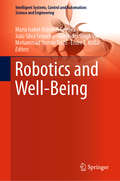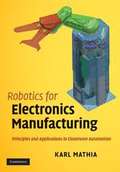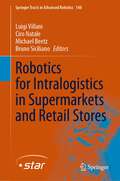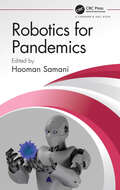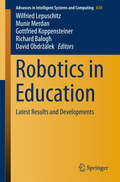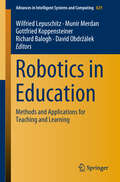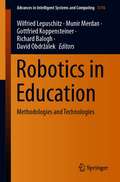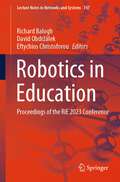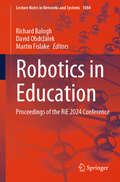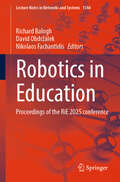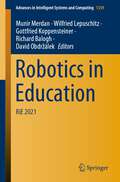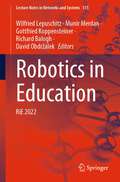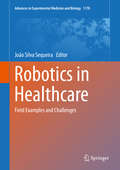- Table View
- List View
Robotics and Smart Autonomous Systems: Technology and Applications (Wireless Communications and Networking Technologies)
by Rashmi Priyadarshini Amit Sehgal Prabhu Jyot Singh Ram Mohan MehraThe text discusses fundamental, advanced concepts and applications of robotics and autonomous systems. It further discusses important topics, such as robotics techniques in the manufacturing sector, applications of smart autonomous systems in the healthcare sector, resource optimization in mobile robotics, and smart autonomous transport systems. Features Covers design and application aspects of robotic systems for implementing the concepts of smart manufacturing with reduced human intervention, better accuracy, and enhanced production capacity. Discusses techniques including supervised learning, unsupervised learning, and reinforced learning with real-life examples. Highlights a unified intermodal approach for automated transportation including cars, trucks, ships, and port management. Explains the mechanical design of planetary rovers, and the mechanical design of space manipulators, actuators, and sensors. Presents programming tools and platforms for autonomous robotic systems. The book is primarily written for senior undergraduates, graduate students, and academic researchers in fields including electrical engineering, electronics and communications engineering, computer science and engineering, and automotive engineering.
Robotics and Well-Being: The Role Of Ethics And Standardization (Intelligent Systems, Control and Automation: Science and Engineering #95)
by Maria Isabel Aldinhas Ferreira Mohammad Osman Tokhi Endre E. Kadar Gurvinder Singh Virk João Silva SequeiraThis book highlights some of the most pressing safety, ethical, legal and societal issues related to the diverse contexts in which robotic technologies apply. Focusing on the essential concept of well-being, it addresses topics that are fundamental not only for research, but also for industry and end-users, discussing the challenges in a wide variety of applications, including domestic robots, autonomous manufacturing, personal care robots and drones.
Robotics for Electronics Manufacturing
by Karl MathiaUnderstand the design, testing, and application of cleanroom robotics and automation with this practical guide. From the history and evolution of cleanroom automation to the latest applications and industry standards, this book provides the only complete overview of the topic available. With over 20 years' industry experience in robotics design, Karl Mathia provides numerous real-world examples to enable you to learn from professional experience, maximize the design quality and avoid expensive design pitfalls. You'll also get design guidelines and hands-on tips for reducing design time and cost. Compliance with industry and de-facto standards for design, assembly, and handling is stressed throughout, and detailed discussions of recommended materials for atmospheric and vacuum robots are included to help shorten product development cycles and avoid expensive material testing. This book is the perfect practical reference for engineers working with robotics for electronics manufacturing in a range of industries that rely on cleanroom manufacturing.
Robotics for Intralogistics in Supermarkets and Retail Stores (Springer Tracts in Advanced Robotics #148)
by Bruno Siciliano Michael Beetz Ciro Natale Luigi VillaniThis book aims at sharing knowledge about the technological opportunities and the main research challenges regarding robotics for logistics in supermarkets and retail stores, from the perspectives of the end-users, logistic companies, technology providers, and robotic researchers. The authors have been involved into the H2020 project Robotics Enabling Fully Integrated Logistics Lines for Supermarkets (REFILLS), aimed at improving logistics in supermarkets thanks to mobile robotic systems in close and smart collaboration with humans. The readers will find a comprehensive analysis of the main logistic processes in retail stores with possible robotized solutions, involving mechanical design, perception, and control. These technologies have been validated in realistic environments, and some of them have been tested into real supermarkets. The book is intended for a broad academic and industrial readership, including operators in the field of logistics, distribution, and retail.
Robotics for Pandemics
by Hooman SamaniRobotics for Pandemics explores various applications of robots for current global issues such as pandemics and how robotic solutions could combat the virus. Key Features Proposes to employ robots to improve the treatment of patients and leverage the load of the medical system Demonstrates the concept of various robotics in healthcare telepresence, rehabilitation, therapy and delivery robots to accommodate social distancing Explores social robot aesthetics and how social interaction and embodied experiences could be useful during social isolation Includes anecdotes from applications used during the COVID-19 pandemic This will be a valuable reference to professionals, academics and researchers in the field of robotics.
Robotics for Sustainable Future: CLAWAR 2021 (Lecture Notes in Networks and Systems #324)
by Manuel F. Silva Mohammad Osman Tokhi Daisuke Chugo Taro Nakamura Khaled GoherThis book presents the proceedings of 24th International Conference Series on Climbing and Walking Robots. CLAWAR 2021 is the twenty-fourth edition of International Conference series on Climbing and Walking Robots and the Support Technologies for Mobile Machines. The conference is organized by CLAWAR Association in collaboration with Kwansei Gakuin University on a virtual platform in Takarazuka, Japan, during 30 August–01 September 2021.CLAWAR 2021 brings new developments and new research findings in robotics technologies within the framework of “Robotics for Sustainable Future”. The topics covered include biped locomotion, human–machine/human–robot interaction, innovative actuators, power supplies and design of CLAWAR, inspection, legged locomotion, modelling and simulation of CLAWAR, outdoor and field robotics, planning and control, and wearable devices and assistive robotics.The intended readership includes participants of CLAWAR 2021 conference, international robotic researchers, scientists, professors of related topics worldwide, and professors and students of postgraduate courses in Robotics and Automation, Control Engineering, Mechanical Engineering, and Mechatronics.
Robotics in Education
by Munir Merdan Wilfried Lepuschitz Gottfried Koppensteiner Richard Balogh David ObdržálekThis proceedings volume showcases the latest achievements in research and development in Educational Robotics presented at the 7th International Conference on Robotics in Education (RiE) held in Vienna, Austria, during April 14-15, 2016. The book offers a range of methodologies for teaching robotics and presents various educational robotics curricula. It includes dedicated chapters for the design and analysis of learning environments as well as evaluation means for measuring the impact of robotics on the students' learning success. Moreover, the book presents interesting programming approaches as well as new applications, the latest tools, systems and components for using robotics. The presented applications cover the whole educative range, from elementary school to high school, college, university and beyond, for continuing education and possibly outreach and workforce development. The book provides a framework involving two complementary kinds of contributions: on the one hand on technical aspects and on the other hand on matters of didactic.
Robotics in Education
by Munir Merdan Wilfried Lepuschitz Gottfried Koppensteiner Richard BaloghThis proceedings volume showcases the latest achievements in research and development in Educational Robotics presented at the 7th International Conference on Robotics in Education (RiE) held in Vienna, Austria, during April 14-15, 2016. The book offers a range of methodologies for teaching robotics and presents various educational robotics curricula. It includes dedicated chapters for the design and analysis of learning environments as well as evaluation means for measuring the impact of robotics on the students' learning success. Moreover, the book presents interesting programming approaches as well as new applications, the latest tools, systems and components for using robotics. The presented applications cover the whole educative range, from elementary school to high school, college, university and beyond, for continuing education and possibly outreach and workforce development. The book provides a framework involving two complementary kinds of contributions: on the one hand on technical aspects and on the other hand on matters of didactic.
Robotics in Education: Latest Results And Developments (Advances In Intelligent Systems and Computing #630)
by Munir Merdan Wilfried Lepuschitz Gottfried Koppensteiner Richard Balogh David ObdržálekThis proceedings volume comprises the latest achievements in research and development in educational robotics presented at the 9th International Conference on Robotics in Education (RiE) held in Qawra, St. Paul's Bay, Malta, during April 18-20, 2018. Researchers and educators will find valuable methodologies and tools for robotics in education that encourage learning in the fields of science, technology, engineering, arts and mathematics (STEAM) through the design, creation and programming of tangible artifacts for creating personally meaningful objects and addressing real-world societal needs. This also involves the introduction of technologies ranging from robotics platforms to programming environments and languages. Extensive evaluation results are presented that highlight the impact of robotics on the students’ interests and competence development. The presented approaches cover the whole educative range from elementary school to the university level in both formal as well as informal settings.
Robotics in Education: Methodologies and Technologies (Advances in Intelligent Systems and Computing #1316)
by Munir Merdan Wilfried Lepuschitz Gottfried Koppensteiner Richard Balogh David ObdržálekThis proceedings book comprises the latest achievements in research and development in educational robotics presented at the 11th International Conference on Robotics in Education (RiE), which was carried out as a purely virtual conference from September 30 to October 2, 2020. Researchers and educators will find valuable methodologies and tools for robotics in education that encourage learning in the fields of science, technology, engineering, arts and mathematics (STEAM) through the design, creation and programming of tangible artifacts for creating personally meaningful objects and addressing real-world societal needs. This also involves the introduction of technologies ranging from robotics platforms to programming environments and languages. Evaluation results prove the impact of robotics on the students’ interests and competence development. The presented approaches cover the whole educative range from elementary school to university in both formal as well as informal settings.
Robotics in Education: Proceedings of the RiE 2023 Conference (Lecture Notes in Networks and Systems #747)
by Richard Balogh David Obdržálek Eftychios ChristoforouThis book provides an overview of Educational Robotics and includes information that reflects the current status of the field, research activity, experiences, and new tools. It compiles the contributions presented at the 14th International Conference on Robotics in Education (RiE2023). Beyond insights into theoretical aspects, practical projects and syllabus activities exemplify the concepts and provide implementation ideas, which span the whole educational system from kindergarten to the university level. The relevance to science, technology, engineering, and mathematics (STEM) education is highlighted by teaching the topics in a unified framework. The book constitutes a valuable resource for educators, researchers, scientists, and engineers interested in robotics. It covers topics including school teaching curricula, educational methodologies and pedagogy, projects, competitions, hardware, simulations, programming, machine learning, and artificial intelligence in education.
Robotics in Education: Proceedings of the RiE 2024 Conference (Lecture Notes in Networks and Systems #1084)
by Richard Balogh David Obdržálek Martin FislakeThe 2024th edition of Robotics in Education is based on the 15th Conference on Robotics in Education (RiE2024) mirroring experts’ knowledge from all over the world. It includes and summarizes all accepted papers from an interdisciplinary community, which met traditionally at the annual Robotics in Education conference making it a valuable resource for educators, researchers, scientists and engineers. Without losing the focus on educational robotics, the topics have been carefully expanded this year. Therefore, the contributions ranges from theory to practice and from primary schools to university labs while the content covers experience reports from out of school programs to didactic-methodological approaches in teacher training and artificial intelligence to human robotics interaction. Also new robot designs, robot competitions and aspects of maker spaces were considered. The anniversary edition of the conference took place from 10.-12. April 2024 at the University of Koblenz in Germany.
Robotics in Education: Proceedings of the RiE 2025 Conference (Lecture Notes in Networks and Systems #1544)
by Richard Balogh David Obdržálek Nikolaos FachantidisExplore cutting-edge research and practical insights from the 16th International Conference on Robotics in Education (RiE2025), held in Thessaloniki. This comprehensive volume gathers peer-reviewed papers from a global interdisciplinary community, covering the latest advancements in educational robotics. From innovative teaching methodologies and curriculum development across all educational levels to the exciting intersections of AI, human-robot interaction, new robot designs, and maker spaces, this book is an essential resource for educators, researchers, scientists, and engineers driving the future of robotics in education.
Robotics in Education: RiE 2021 (Advances in Intelligent Systems and Computing #1359)
by Munir Merdan Wilfried Lepuschitz Gottfried Koppensteiner Richard Balogh David ObdržálekThis book comprises the latest achievements in research and development in educational robotics presented at the 12th International Conference on Robotics in Education (RiE), which was carried out as a purely virtual conference from April 28 to 30, 2021. Researchers and educators find valuable methodologies and tools for robotics in education that encourage learning in the fields of science, technology, engineering, arts, and mathematics (STEAM) through the design, creation, and programming of tangible artifacts for creating personally meaningful objects and addressing real-world societal needs. This also involves the introduction of technologies ranging from robotics platforms to programming environments and languages. Evaluation results prove the impact of robotics on the students’ interests and competence development. The presented approaches cover the whole educative range from kindergarten, primary and secondary school, to the university level and beyond.
Robotics in Education: RiE 2022 (Lecture Notes in Networks and Systems #515)
by Munir Merdan Wilfried Lepuschitz Gottfried Koppensteiner Richard Balogh David ObdržálekThis book comprises the latest achievements in research and development in educational robotics presented at the 13th International Conference on Robotics in Education (RiE), which was carried out as a purely virtual conference from April 27 to 28, 2022. Researchers and educators will find valuable methodologies, experiences, and tools for robotics in education that encourage learning in the fields of science, technology, engineering, arts, and mathematics (STEAM) through the design, creation, and programming of robots addressing real-world societal needs. Social robotics is becoming an important topic in education as well. This also involves various modern technologies ranging from robotics platforms to programming environments and languages. Many papers also prove the positive impact of robotics on the students’ interests and competence development. The presented approaches cover the whole educative range from kindergarten to the university level and lifelong learning.
Robotics in Healthcare: Field Examples and Challenges (Advances in Experimental Medicine and Biology #1170)
by João Silva SequeiraThe work is a collection of contributions resulting from R&D efforts originated from scientific projects involving academia, technological partners, and end-user institutions. The aim is to provide a comprehensive overview of robotics technology applied to Healthcare, and discuss the anticipation of upcoming challenges.The intersection of Robotics and Medicine includes socially and economically relevant areas, such as rehabilitation, therapy, and healthcare. Innovative usages of current robotics technologies are being somewhat stranded by concerns related to social dynamics. The examples covered in this volume show some of the potential societal benefits robotics can bring and how the robots are being integrated in social environments.Despite the aforementioned concerns, a fantastic range of possibilities is being opened. The current trend in social robotics adds to technology challenges and requires R&D to think about Robotics as an horizontal discipline, intersecting social and exact sciences. For example, robots that can act as if they have credible personalities (not necessarily similar to humans) living in social scenarios, eventually helping people. Also, robots can move inside the human body to retrieve information that otherwise is difficult to obtain. The decision autonomy of these robots raises a broad range of subjects though the immediate advantages of its use are evident.The book presents examples of robotics technologies tested in healthcare environments or realistically close to being deployed in the field and discusses the challenges involved. Chapter 1 provides a comprehensive overview of Healthcare robotics and points to realistically expectable developments in the near future. Chapter 2 describes the challenges deploying a social robot in the Pediatrics ward of an Oncological hospital for simple edutainment activities. Chapter 3 focuses on Human-Robot Interaction techniques and their role in social robotics. Chapter 4 focus on R&D efforts behind an endoscopic capsule robot. Chapter 5 addresses experiments in rehabilitation with orthotics and walker robots. These examples have deep social and economic relations with the Healthcare field, and, at the same time, are representative of the R&D efforts the robotics community is developing.
Robotics in Natural Settings: CLAWAR 2022 (Lecture Notes in Networks and Systems #530)
by Armando Mendes Manuel F. Silva Mohammad Osman Tokhi Matthias Funk Khaled Goher José M. CascalhoThis book includes recent research on climbing and walking robots. CLAWAR 2022 is the twenty-fifth International Conference Series on Climbing and Walking Robots and Mobile Machine Support Technologies. The conference is organized by CLAWAR Association in collaboration with the University of the Azores, S. Miguel, Portugal, during September 12-14, 2022. CLAWAR 2022 provides an updated state of the art on robotics and its use in a diversity of applications and/or simulation scenarios, within the framework “Robotics in Natural Settings”. The topics covered include Bio-Inspired Robotics, Biped Locomotion, Educational Robotics, Human-Machine/Human-Robot Interaction, Innovative Actuators, Inspection, Legged Locomotion, Modeling and Simulation of CLAWAR, Outdoor and Field Robotics, Planning and Control, Wearable Devices and Assistive Robotics, and the Use of A.I. in Robotics. The intended readership includes participants of CLAWAR 2022 conference, international robotic researchers, scientists, and professors of related topics worldwide, and professors and students of postgraduate courses in Robotics and Automation, Control Engineering, Mechanical Engineering, and Mechatronics.
Robotics in STEM Education
by Myint Swe KhineThis book describes recent approaches in advancing STEM education with the use of robotics, innovative methods in integrating robotics in school subjects, engaging and stimulating students with robotics in classroom-based and out-of-school activities, and new ways of using robotics as an educational tool to provide diverse learning experiences. It addresses issues and challenges in generating enthusiasm among students and revamping curricula to provide application focused and hands-on approaches in learning . The book also provides effective strategies and emerging trends in using robotics, designing learning activities and how robotics impacts the students' interests and achievements in STEM related subjects. The frontiers of education are progressing very rapidly. This volume brought together a collection of projects and ideas which help us keep track of where the frontiers are moving. This book ticks lots of contemporary boxes: STEM, robotics, coding, and computational thinking among them. Most educators interested in the STEM phenomena will find many ideas in this book which challenge, provide evidence and suggest solutions related to both pedagogy and content. Regular reference to 21st Century skills, achieved through active collaborative learning in authentic contexts, ensures the enduring usefulness of this volume. John Williams Professor of Education and Director of the STEM Education Research Group Curtin University, Perth, Australia
Robotics, AI and the Future of Law (Perspectives in Law, Business and Innovation)
by Mark Fenwick Marcelo Corrales Nikolaus Forgó<p>Artificial intelligence and related technologies are changing both the law and the legal profession. In particular, technological advances in fields ranging from machine learning to more advanced robots, including sensors, virtual realities, algorithms, bots, drones, self-driving cars, and more sophisticated “human-like” robots are creating new and previously unimagined challenges for regulators. These advances also give rise to new opportunities for legal professionals to make efficiency gains in the delivery of legal services. With the exponential growth of such technologies, radical disruption seems likely to accelerate in the near future. <p>This collection brings together a series of contributions by leading scholars in the newly emerging field of artificial intelligence, robotics, and the law. The aim of the book is to enrich legal debates on the social meaning and impact of this type of technology. <p>The distinctive feature of the contributions presented in this edition is that they address the impact of these technological developments in a number of different fields of law and from the perspective of diverse jurisdictions. Moreover, the authors utilize insights from multiple related disciplines, in particular social theory and philosophy, in order to better understand and address the legal challenges created by AI. Therefore, the book will contribute to interdisciplinary debates on disruptive new AI technologies and the law.</p>
Robotics, Control and Computer Vision: Select Proceedings of ICRCCV 2022 (Lecture Notes in Electrical Engineering #1009)
by Richi Nayak Hariharan Muthusamy János BotzheimThis book presents select peer-reviewed papers from the International Conference on Robotics, Control, and Computer Vision (ICRCCV 2022). The contents focus on the latest research in the field of Robotics, their control, and computer vision in the context of robotics. The contributed papers have been arranged to give a flow to the reader. This book will be useful for students, researchers, and professionals from multidisciplinary fields such as mechanical engineering, electronics engineering, electrical engineering, computer science, and mathematics.
Robotics, Machinery and Engineering Technology for Precision Agriculture: Proceedings of XIV International Scientific Conference “INTERAGROMASH 2021” (Smart Innovation, Systems and Technologies #247)
by Marco Pasetti Mark Shamtsyan Alexey BeskopylnyThis book is a collection of papers presented at XIV International Scientific Conference “INTERAGROMASH 2021”, held at Don State Technical University, Rostov-on-Don, Russia, during 24–26 February 2021. The research results presented in this book cover applications of unmanned aerial systems, satellite-based applications for precision agriculture, proximal and remote sensing of soil and crop, spatial analysis, variable-rate technology, embedded sensing systems, drainage optimization and variable rate irrigation, wireless sensor networks, Internet of things, robotics, guidance and automation, software and mobile apps for precision agriculture, decision support for precision agriculture and data mining for precision agriculture.
Robotics, Vision And Control: Fundamental Algorithms In Matlab - 2nd, Completely Revised, Extended And Updated Edition (Springer Tracts In Advanced Robotics #118)
by Peter CorkeRobotic vision, the combination of robotics and computer vision, involves the application of computer algorithms to data acquired from sensors. The research community has developed a large body of such algorithms but for a newcomer to the field this can be quite daunting. For over 20 years the author has maintained two open-source MATLAB® Toolboxes, one for robotics and one for vision. They provide implementations of many important algorithms and allow users to work with real problems, not just trivial examples. <P><P>This book makes the fundamental algorithms of robotics, vision and control accessible to all. It weaves together theory, algorithms and examples in a narrative that covers robotics and computer vision separately and together. Using the latest versions of the Toolboxes the author shows how complex problems can be decomposed and solved using just a few simple lines of code. The topics covered are guided by real problems observed by the author over many years as a practitioner of both robotics and computer vision. It is written in an accessible but informative style, easy to read and absorb, and includes over 1000 MATLAB and Simulink® examples and over 400 figures. The book is a real walk through the fundamentals of mobile robots, arm robots. then camera models, image processing, feature extraction and multi-view geometry and finally bringing it all together with an extensive discussion of visual servo systems. This second edition is completely revised, updated and extended with coverage of Lie groups, matrix exponentials and twists; inertial navigation; differential drive robots; lattice planners; pose-graph SLAM and map making; restructured material on arm-robot kinematics and dynamics; series-elastic actuators and operational-space control; Lab color spaces; light field cameras; structured light, bundle adjustment and visual odometry; and photometric visual servoing. “An authoritative book, reaching across fields, thoughtfully conceived and brilliantly accomplished!”
Robotics, Vision and Control: Fundamental Algorithms in MATLAB® (Springer Tracts in Advanced Robotics #147)
by Peter Corke Witold Jachimczyk Remo PillatThis textbook provides a comprehensive, but tutorial, introduction to robotics, computer vision, and control. It is written in a light but informative conversational style, weaving text, figures, mathematics, and lines of code into a cohesive narrative. Over 1600 code examples show how complex problems can be decomposed and solved using just a few simple lines of code. This edition is based on MATLAB® and a number of MathWorks® toolboxes. These provide a set of supported software tools for addressing a broad range of applications in robotics and computer vision. These toolboxes enable the reader to easily bring the algorithmic concepts into practice and work with real, non-trivial, problems. For the beginning student, the book makes the algorithms accessible, the toolbox code can be read to gain understanding, and the examples illustrate how it can be used. The code can also be the starting point for new work, for practitioners, students, or researchers, by writing programs based on toolbox functions. Two co-authors from MathWorks have joined the writing team and bring deep knowledge of these MATLAB toolboxes and workflows.
Robotics, Vision and Control: Fundamental Algorithms in Python (Springer Tracts in Advanced Robotics #146)
by Peter CorkeThis textbook provides a comprehensive, but tutorial, introduction to robotics, computer vision, and control. It is written in a light but informative conversational style, weaving text, figures, mathematics, and lines of code into a narrative that covers robotics and computer vision—separately, and together as robotic vision. Over 1600 code examples show how complex problems can be decomposed and solved using just a few simple lines of code. This edition is based on Python and is accompanied by fully open-source Python-based Toolboxes for robotics and machine vision. The new Toolboxes enable the reader to easily bring the algorithmic concepts into practice and work with real, non-trivial, problems on a broad range of computing platforms. For the beginning student the book makes the algorithms accessible, the Toolbox code can be read to gain understanding, and the examples illustrate how it can be used. The code can also be the starting point for new work, for practitioners, students, or researchers, by writing programs based on Toolbox functions, or modifying the Toolbox code itself.
Robotics: From Theory to Practice
by Chao Chen Wesley Au Shao LiuRobotics: From Theory to Practice introduces robotic theories and technologies to audiences, including university students, professionals with engineering backgrounds, and even high-school students interested in building their own robots. We aim to bridge the gap between classic theories and real-world applications of robotic manipulators, which, to date, have far exceeded the domain of conventional industry.The contents are divided into three parts. The first two cover classic theories of robotics, including kinematics, dynamics, path planning, control, and programming. Specifically, Part I is an introduction targeting junior students, featuring more simplistic topics and examples. Part II provides the senior students and professionals with more in-depth discussions on critical topics and more comprehensive examples. In Part III, we demonstrate how classic robotics theory can be extended to more advanced theoretical frameworks and adopted in real-world applications beyond conventional industries.This textbook is valuable to broad readers, including those who have limited background in general engineering and wish to explore non-conventional applications of robotic manipulators. The scaffolded contents from Part I to Part III are created to lower the prerequisites and smooth the learning curve.

